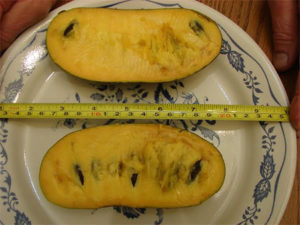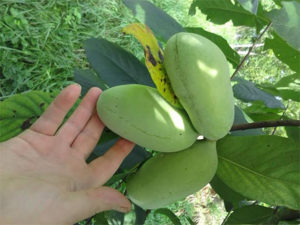 The fruit is a relative of the papaya, and is the largest fruit native in America. Found in rich bottom lands and at woods edges from Ontario to Florida, west to Texas and Nebraska; let’s take a fresh look at the forgotten pawpaw patch tree and it’s fruit.
The fruit is a relative of the papaya, and is the largest fruit native in America. Found in rich bottom lands and at woods edges from Ontario to Florida, west to Texas and Nebraska; let’s take a fresh look at the forgotten pawpaw patch tree and it’s fruit.
Historically enjoyed by natives and frontiersmen, pawpaws are relatively unknown except perhaps to the kayaker or fisherman, or an occasional farmer’s market. A favorite dessert of George Washington’s, and was also grown by Thomas Jefferson at Monticello. The short shelf life keeps the pawpaw from appearing at the typical grocery store. It’s the farmer, or the homeowner on a mission to eat local and grow natives that has brought this old-timer some renewed interest.
Pawpaws need partial shade for the seeds to sprout and for the first year or two, but larger trees do just fine in full sun. Mature trees can be from 10 to 30 feet in size, depending on richness of the soil. They make good shade, once mature, and have lovely yellow fall color. They have a taproot and their roots aren’t a problem in landscaping situations, but larger trees may be a bit difficult to transplant successfully.
 Pawpaws are very high in proteins, vitamins A and C, potassium, phosphorus, magnesium and sulphur (more so than apples, oranges, grapes or peaches), and have antioxident and insecticidal properties and are being studied for cancer fighting drug possibilities. With a fruit somewhat like a banana or avocado or like a banana custard or banana muskmelon, it’s loved by humans as well as raccoons, opossums, deer and several species of birds. The larvae of the tiger swallowtail butterfly depend on pawpaw leaves for food, but their numbers aren’t large enough to do significant damage to the bushes/trees.
Pawpaws are very high in proteins, vitamins A and C, potassium, phosphorus, magnesium and sulphur (more so than apples, oranges, grapes or peaches), and have antioxident and insecticidal properties and are being studied for cancer fighting drug possibilities. With a fruit somewhat like a banana or avocado or like a banana custard or banana muskmelon, it’s loved by humans as well as raccoons, opossums, deer and several species of birds. The larvae of the tiger swallowtail butterfly depend on pawpaw leaves for food, but their numbers aren’t large enough to do significant damage to the bushes/trees.
For fruit set, plant more than one pawpaw to provide cross pollination. (If there are wild ones along a nearby branch or creek, you can probably skip that advice.) For landscape use, plant from one to a whole cluster. In fact, the pawpaw “patch” is usually produced from an old pawpaw root sending up sprouts, so several in a wild clump may not produce fruit because the genetics are all the same.
A few more pawpaw highlights: They have a few big seeds (think sort of like size of melon seeds). Typical fruit size is 3 to six inches with a bean or kidney shape. Some grafted pawpaws have fruit nearing one pound, but most pawpaws are three to five ounces. The peel is like a papaya and is not eaten; the green peel turns a more yellowish color when ripe. The trees have few serious diseases or pests, so work well for the organic grower or homeowner.
Photos with this story are courtesy of Englands Orchard and Nursery near Sand Gap in Jackson County, Kentucky. Their website is www.nuttrees.net. Another source of information on pawpaws is Kentucky State University: www.pawpaw.kysu.edu. Or feel free to email your questions to pondbuilder@hushmail.com and I will promise a reply.
Planting a pawpaw tree at your place can help in creating paradise.